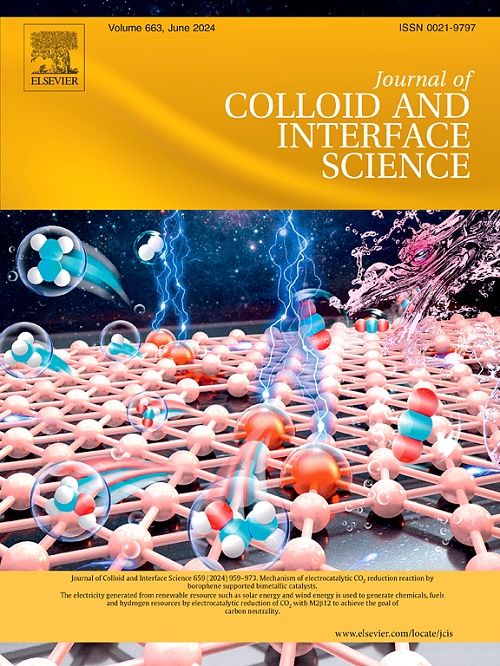氧化还原活性石墨烯分散剂及其提高碳膜电导率和赝电容的能力
IF 9.4
1区 化学
Q1 CHEMISTRY, PHYSICAL
引用次数: 0
摘要
在制备石墨烯基复合材料时,强范德华力和π -π相互作用使得石墨烯难以均匀分布在基体中。分散剂的应用是解决这一问题的主要方法,但现有的分散剂,如市售的表面活性剂和聚合物稳定剂,几乎不能提供理想的效果。此外,它们在最终的复合材料中总是“无用”的,但很难去除。因此,赋予分散剂与最终复合材料的应用相匹配的特定性能是必不可少的。本文以对苯二胺(PDA)与环氧基接枝并与乙胺反应为基础,研制了一种氧化还原活性石墨烯分散剂(RAGD)。采用尖端超声法制备了均匀的石墨烯水性分散体,采用真空过滤法制备了均匀的石墨烯基薄膜。发现石墨烯在RAGD的存在下可以均匀分散在浓度高达15 mg mL−1的水中,并且可以在室温下稳定存在6个月以上。由于PDA共轭中心具有氧化还原活性,RAGD与石墨烯的π -π相互作用是可调节的,并且在碱处理下RAGD可以部分地从石墨烯中去除。经1 mol L−1 NH3·H2O处理后,石墨烯薄膜的电导率提高了约34%。此外,含有RAGD的石墨烯基薄膜也显示出比使用常用表面活性剂制备的薄膜更高的比电荷电容。本文章由计算机程序翻译,如有差异,请以英文原文为准。

Redox-active graphene dispersant and its ability to improve the conductivity and pseudo-capacitance of carbon film
Hypothesis
Strong van der Waals force and π–π interaction make graphene difficult to be uniformly distributed in basic matrix for fabricating graphene-based composites. Employing dispersant is a major solution, however, current existing dispersants such as commercially available surfactants and polymer stabilizers scarcely provide ideal effect. Besides, they are always “useless” in final composites but difficult to remove. Therefore, endowing dispersant with specific property that matching the application of the final composite is essential.
Experiments
Herein, a redox-active graphene dispersant (RAGD) is developed based on the grafting of p-phenylenediamine (PDA) with epoxy groups and further reacting with ethylamine. Homogeneous aqueous graphene dispersion is prepared by tip-sonication, and uniform graphene-based films are prepared via vacuum filtration method.
Findings
Graphene can be homogenously dispersed in water with concentration up to 15 mg mL−1 in the presence of RAGD, and it can stably exist at room temperature for over six months. The π–π interaction of RAGD with graphene is tunable due to the PDA conjugated center is redox-active, and RAGD can be partially eliminated from graphene under alkali treatment. The electrical conductivity of the graphene film increases by about 34% after treated by 1 mol L−1 NH3·H2O. Additionally, the graphene-based film including RAGD also shows much higher specific charge capacitance than those made with commonly used surfactants.
求助全文
通过发布文献求助,成功后即可免费获取论文全文。
去求助
来源期刊
CiteScore
16.10
自引率
7.10%
发文量
2568
审稿时长
2 months
期刊介绍:
The Journal of Colloid and Interface Science publishes original research findings on the fundamental principles of colloid and interface science, as well as innovative applications in various fields. The criteria for publication include impact, quality, novelty, and originality.
Emphasis:
The journal emphasizes fundamental scientific innovation within the following categories:
A.Colloidal Materials and Nanomaterials
B.Soft Colloidal and Self-Assembly Systems
C.Adsorption, Catalysis, and Electrochemistry
D.Interfacial Processes, Capillarity, and Wetting
E.Biomaterials and Nanomedicine
F.Energy Conversion and Storage, and Environmental Technologies

 求助内容:
求助内容: 应助结果提醒方式:
应助结果提醒方式:


